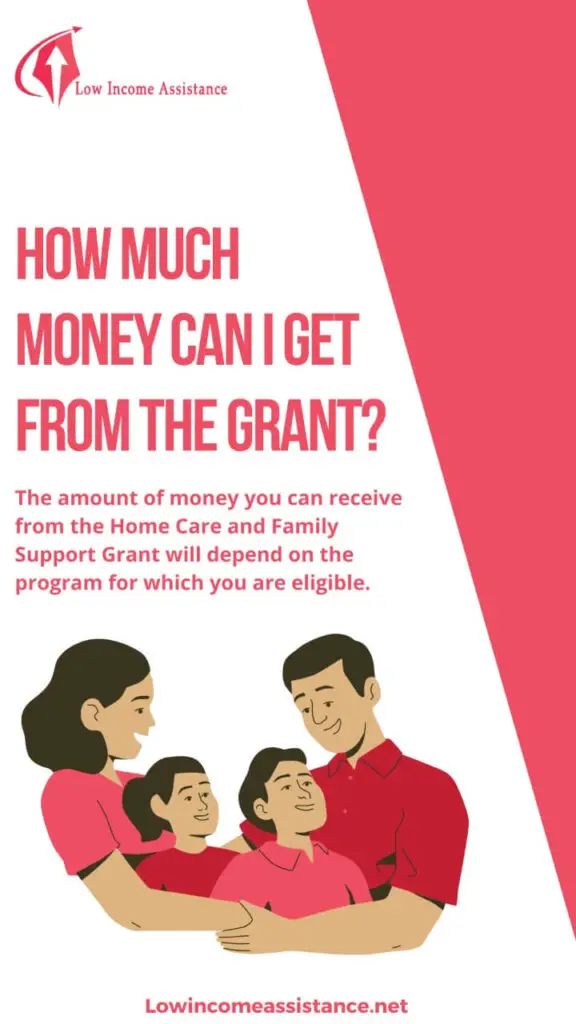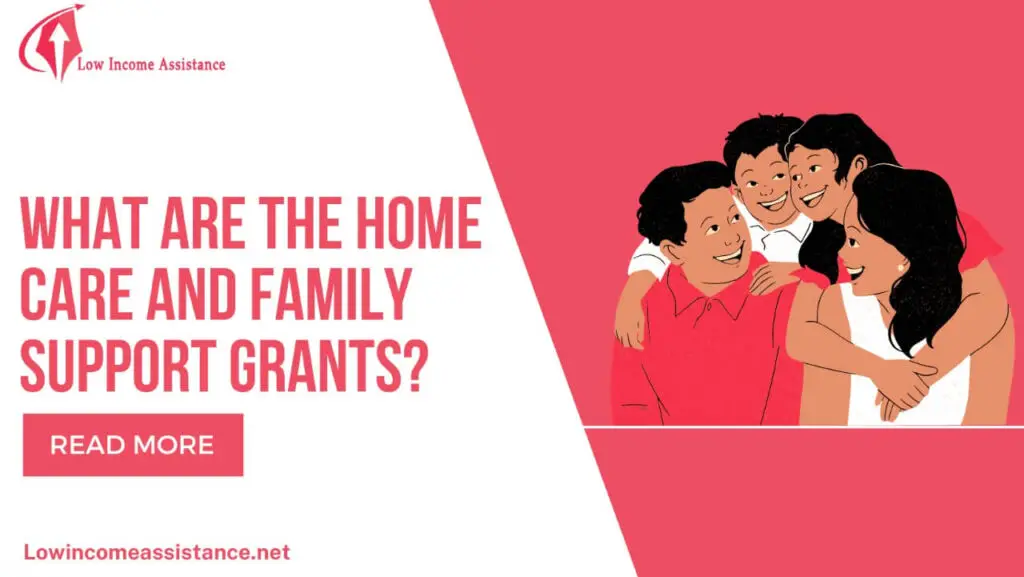The Federal Home Care and Family Support Grant is a great way to help families who are struggling to make ends meet. This grant can provide financial assistance for home care and family support services, allowing families to stay in their homes, receive needed services, and be better equipped to take care of their loved ones.
In this blog post, we’ll discuss how to get the most out of the Home Care and Family Support Grant so you can make the most of this opportunity.
What Are The Home Care And Family Support Grants?
The Home Care and Family Support Grant is a financial assistance program designed to provide financial help to those individuals and families who need additional support. The grant is available to individuals and families who are eligible for income and resources that meet the eligibility requirements.
The grant assists with medical care, housing, education, child care, job training and employment, transportation, and other services. The grant can also provide emergency assistance to those in financial need.
The grant is funded by the federal government and is administered through state and local government agencies. Eligibility is based on income, assets, family size, disability status, and other factors. The amount of money available will depend on the level of need and the state’s budget.
The grant is meant to help individuals and families maintain independence and stay connected to their communities. It can also help provide an important source of financial assistance to those who need it most. The grant can help cover basic needs such as food, shelter, clothing, transportation, health care, education, job training, and more.
The Home Care and Family Support Grant is designed to help those in need have access to essential services. If you think you may qualify for the grant, contact your local agency or community organization to learn more about how to apply.
Free Home Repairs Grants For Veterans
-
Family Support Grant (FSG)
The FSG program is intended to provide financial assistance to families of disabled children who are at risk of out-of-home replacement. The grant is meant to supplement existing resources for families, to tor financial burden, and enhance their quality of life.
To qualify for the grant, the applicant must be a legal guardian of a disabled child aged 18 and under, or between the ages of 19-21 if the disability began before the birthday. The child must also have a certified disability and an individualized family service plan (IFSP) that outlines their unique needs.
You can apply for the FSG by contacting your local Social Services Office. They will help you fill out the necessary forms and pre-guide to proceed. The grant is designed to help families meet the costs associated with caring for a disabled child.
This includes medical expenses, childcare, special education costs, home care services, and more. The money from the grant can also be used for other activities that promote family well-being, such as parent support groups, counseling, and recreational activities.
Deadlines vary depending on your state’s requirements. In general, applications must be submitted within 90 days of the date of the application. The amount of money available depends on various ores, such as family size and income level.
Generally, the maximum amount of money a family can receive is $2,000 per year. However, this amount may vary depending on your family’s unique needs family.
Free Cremation For Low-Income Families 2023
-
Temporary Assistance For Needy Families (TANF)
Temporary Assistance for Needy Families (TANF) is a welfare program that helps families with children and limited income by providing cash assistance and other services. This federal program was created in 1996, replacing the Aid to Families with Dependent Children (AFDC) program.
TANF is funded by the federal government, but each state has its TANF program with varying eligibility criteria. You can contact your local county social services agency for help. You can also call your state TANF office to get local contact information and sign up for the benefits.
Some of the major benefits of TANF include:-
- Assisting families in need.
- Providing children with specific help.
- Providing income supplementation to recipients who are employed.
- To boost independence, job training can be provided.
- Assisting with child care and transportation costs.
- Providing education and training that promote self-sufficiency.
- Connecting individuals with resources for job search or job training.
To be eligible for TANF, you must meet certain requirements. These requirements vary from state to state, so make sure to check with your local county social services agency for more information on eligibility criteria in your state.
Generally speaking, some of the main requirements include having a low income, having a minor child in your home, being a U.S. citizen or legal resident, and living in the state where you are applying for benefits.
If you believe you meet all the eligibility requirements, you can then apply for the TANF benefits. You can apply at your local county social services office, or if you have access to the internet, you can apply online through your state’s website.
You will need to provide proof of identity and other required documents to complete the application process. Once approved, you will receive cash assistance and other benefits depending on your state’s TANF program.
You may also receive additional benefits such as job training, child care assistance, and education or training activities to help you become self-sufficient. The Temporary Assistance for Needy Families program is designed to provide aid to those in need and give them a hand up toward achieving self-sufficiency.
Churches that help families in need
With the help of this program, individuals and families can receive the help they need to get back on their feet and begin to lead independent lives.
-
Supplemental Security Income (SSI)
Supplemental Security Income (SSI) is a government-funded program administered by the Social Security Administration that provides a monthly cash payment to individuals who are age 65 or older, blind, or disabled, and have limited income and resources.
SSI can be used to pay for basic living expenses like food, clothing, and shelter. To qualify for SSI, individuals must meet certain criteria including meeting the income and resource requirements as well as having a disability or being age 65 or older.
In addition to providing cash assistance to individuals who need it, SSI also provides benefits such as medical coverage and help with funeral costs. Individuals who receive SSI may also be eligible for state-run programs such as home care or transportation services.
These programs can assist those who need extra help to maintain independence and dignity. To apply for SSI, individuals must complete an application and provide information about their income, resources, and medical condition.
The Social Security Administration will review the application and decide based on the information provided. If approved, individuals will receive a monthly check and can start using the funds to cover basic living expenses.
-
Subsidized Rental Housing
The program helps low-income households pay rent with subsidies. Subsidized rental housing gives people who are eligible an opportunity to live in a safe, clean and affordable home or apartment.
The amount of rent that you have to pay is determined by your income.
The government will make sure that you do not have to spend more than 30% of your income on housing costs. Flexible Payment Options: With the Home Care and Family Support Grant, you can also benefit from flexible payment options.
This allows you to decide how much money to pay towards your rent each month and what payment plans the best suit your needs. It also allows for additional payments for unforeseen expenses like medical bills or additional car repairs.
With flexible payment options, you can also use part of your monthly rent payments to go towards furniture, food, school supplies, and other essentials for yourself or your family.
-
Social Security Disability Insurance (SSDI)
Social Security Disability Insurance (SSDI) is a federally funded program that provides financial support to individuals who are unable to work due to a disability. The program is administered by the Social Security Administration (SSA).
SSDI provides benefits to individuals who have worked in the past and paid taxes into the Social Security system. The amount of benefits an individual can receive depends on the amount of taxes they have paid into the system.
To qualify for SSDI, an individual must be diagnosed with a disability that has lasted, or is expected to last, at least 12 months and prevents them from working. Additionally, the applicant must have worked and paid taxes into the Social Security system for at least five of the past ten years before becoming disabled.
Finally, the applicant must demonstrate that their disability prevents them from performing any job in the economy. Once approved for SSDI, an individual will receive monthly benefits for an indefinite period.
The amount of benefits an individual receives depends on the amount of taxes they have paid into the system. Additionally, depending on their income and resources, an individual may be eligible for additional support from Medicaid and Medicare.
-
The U.S. Department of Health and Human Services
The HHS offers grants to assist with food, clothing, housing, healthcare, transportation, and other necessities. The FSG provides temporary financial assistance to families who are unable to meet their basic needs due to job loss, disability, or other hardships.
TANF is a program that helps low-income families become self-sufficient by providing cash assistance and access to work supports such as child care and job training. SSI provides financial assistance to low-income seniors, people with disabilities, and blind individuals.
Subsidized rental housing is available to low-income individuals and families who are unable to afford the cost of the rent. Finally, the Social Security Disability Insurance (SSDI) program provides cash benefits to people with disabilities who can no longer work.
The Department of Health and Human Services works in partnership with state and local government agencies to provide financial assistance and other forms of support. For more information on the home care and family support grant programs available through the HHS, visit the official website at www.hhs.gov.
-
The 400 Grant
The 400 grant is a special program offered by the U.S. Department of Health and Human Services. This grant provides financial support to families in need of home care and family support services. The 400 grant provides up to $400 per month for a maximum of 12 months, depending on the individual’s situation.
The 400 grant is designed to provide financial support to individuals who need home care and family support services such as respite care, adult day care, or other forms of assistance.
To qualify for the 400 grant, you must be an American citizen and meet the following criteria:-
- Have a disability, chronic illness, or other condition that requires home care and family support services.
- Meet income eligibility requirements.
- Provide proof of identity and residence.
- Demonstrate the need for home care and family support services.
Once you have been approved for the 400 grant, you will receive monthly payments from the U.S. Department of Health and Human Services. These payments can be used to cover home care and family support services such as respite care, adult day care, or other forms of assistance.
The 400 grant is a great way to get the financial help you need to keep your loved one safe and supported at home. With this grant, you can receive up to $400 per month for a maximum of 12 months, depending on your individual needs. To learn more about how you can apply for the 400 grant, contact your local Department of Health and Human Services office today.
How Much Money Can I Get From The Grant?
The amount of money you can receive from the Home Care and Family Support Grant will depend on the program for which you are eligible. The FSG, for example, is based on a sliding scale and may range from $50 to $500 per month depending on your household income.

The Temporary Assistance for Needy Families (TANF) grant provides a fixed amount of money, while the Supplemental Security Income (SSI) program has both a federal and state supplement to the benefit that can vary by state.
Subsidized rental housing grants provide financial assistance to help pay rent, and the Social Security Disability Insurance (SSDI) program can provide up to $2,871 per month depending on your disability status and income.
It is important to keep in mind that the U.S. The Department of Health and Human Services (HHS) may also have additional eligibility requirements for each program, such as having a minimum number of hours worked or needing to be a certain age.
Additionally, the amount of money you can receive from any of these programs may be reduced if you have other sources of income such as Social Security benefits, unemployment benefits, or workers’ compensation.
The best way to determine how much money you can receive from the Home Care and Family Support Grant is to contact your local HHS office or visit the website for more information about eligibility requirements and amounts.
Conclusion:-
Home care and family support grants can be a great way to get the financial assistance you need for your home and family. They provide access to critical funds for those who are unable to work due to age or disability, or who are in financial hardship.
With careful research and preparation, you can make sure that you get the most out of these grants. Knowing the eligibility requirements, the application process, deadlines, and how much money you can receive will help ensure you maximize the benefit of this program.
Frequently Asked Questions
How do I get grant money?
There are various ways to get grant money. You can find grants that fit your individual needs by researching available options from government websites and private organizations. You may also be eligible for a grant through specific programs like the Family Support Grant (FSG) or Temporary Assistance for Needy Families (TANF).
What types of grants are available?
Grants can vary widely in purpose, amount, and qualifications. There are grants available from federal and state governments, nonprofit organizations, private foundations, universities, and other sources. Common types of grants include Supplemental Security Income (SSI), Subsidized Rental Housing, Social Security Disability Insurance (SSDI), and the Family Support Grant (FSG).
What is the most common grant?
The most common grant is the Family Support Grant (FSG). This grant is administered by the U.S. Department of Health and Human Services and provides financial assistance to families in need. It helps pay for food, housing, childcare, and other related costs.
Who qualifies for the 400 grant?
The 400 grant is part of the Family Support Grant your family’s income and size determine eligibility and size. To qualify for this grant, your family must have an income that falls below the poverty level for your area and state. You must also demonstrate a financial need for the funds.
What’s a good reason to get a grant?
Grants can provide valuable financial assistance to those who need it. If you’re struggling to pay for necessities like food, housing, or healthcare costs, a grant can help you cover those costs. Grants can also help you start a business or attend college without having to take out loans or use other forms of credit.














